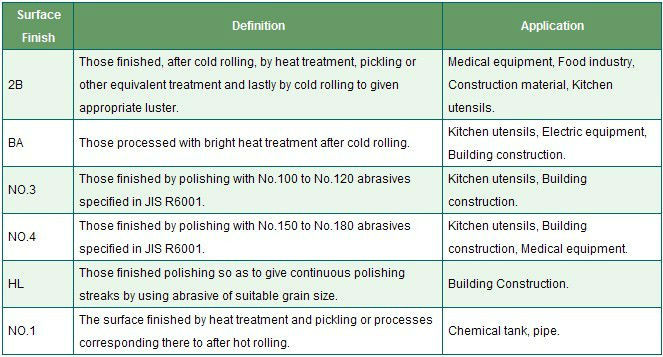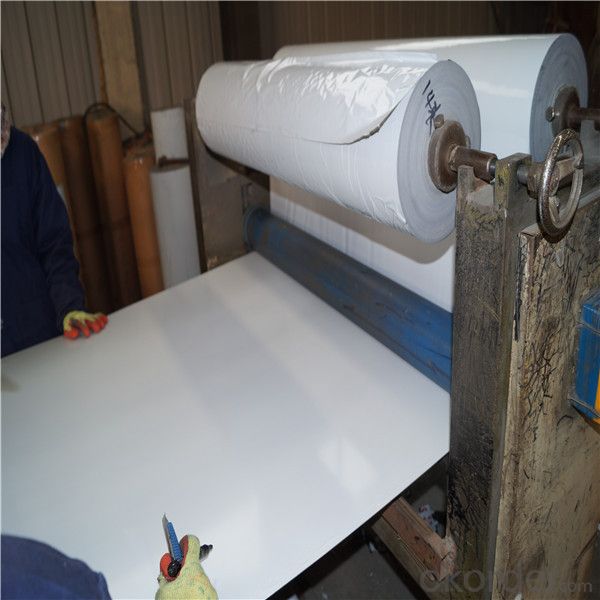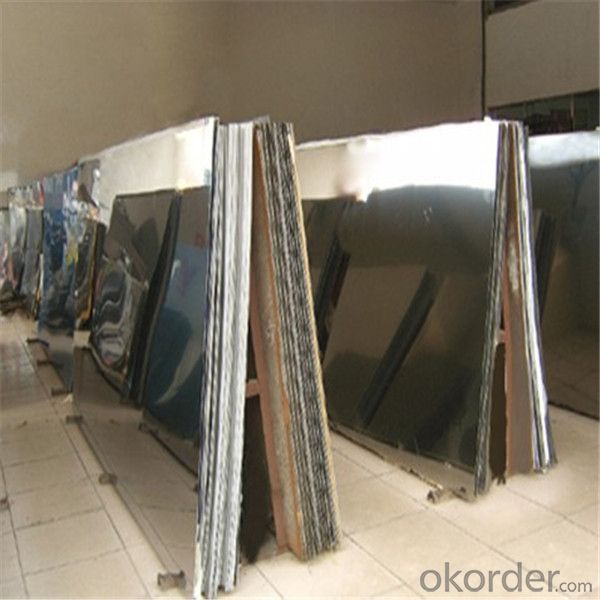310s Stainless Steel Plate/Sheet with BA Surface
- Loading Port:
- Shanghai
- Payment Terms:
- TT OR LC
- Min Order Qty:
- 3 m.t.
- Supply Capability:
- 20000 m.t./month
OKorder Service Pledge
OKorder Financial Service
You Might Also Like
Item specifice
Stainless Steel Plate 310S
Brand name :
Technique: hot rolled or cold rolled
Type : plate
Model number :310S(0Cr25Ni20/1Cr25Ni20Si2)
Thickness : Cold Rolled: 0.3-3, 4, 5,6mm; Hot rolled: 3-120mm
Width :1219mm/1500mm/1800mm or as request
Length : 2438/3000/6000mm, size can be customized
Finish: Cold Rolled: 2B, 2D, BA, NO.4, HL, 8K; Hot Rolled: NO.1, 4K, Polished.
Payment terms: T/T, 30% of value prepaid after signing S/C within three working days, and the balance against the copy of B/L.
Package :standard packing or at customer's request.
Standard :ASTM AISI GB
Certification: ISO
Applications :Widely used in the fields related to chemical equipment and heat resistant parts, and typecally applied in saggers, drying equipment, industrial furnace lining, heat-exchangers, petroleum refinery equipment, etc
TISCO China 310S stainless steel plate price per ton
GRADE | 310s | |
SURFACE | Cold Rolled :2B/NO.4/HL/BA/8K | Hot rolled :NO.1 |
WIDTH(mm) | 1000mm ,1219mm ,1250mm , 1500mm ,1600mm ,1800mm,2000mm ,2500mm etc. | |
THICKNESS(mm) | Cold Rolled :0.3mm,0.4mm,0.5mm,0.6mm,0.7mm, 0.8mm,0.9mm,1.0mm,1.2mm,1.5mm,2.0mm,2.5mm,3.0mm
Hot rolled :3.0mm ,4.0mm,5.0mm,6.0mm,8.0mm,10.0mm, 12.0mm,14.0mm,16.0mm,18.0mm,20.0mm,22.0mm,25.0mm, 28.0mm,30.0mm,32.0mm,35.0mm,38.0mm,40.0mm etc. | |
LENGTH(mm) | According to customer requirements | |
Surface finishes and characteristic
310s Chemical Composition | ||||||
C | Si | Mn | Cr | Ni | S | P |
≤0.08 | ≤1.00 | ≤2.00 | 24.0~26.0 | 19.0~22.0 | ≤0.030 | ≤0.035 |
mechanical properties:
Mechanical properties | |||||||
Heat Treatment | Yield strength(N/mm2) | Tensile strength | Elongation(%) | Hardness | |||
HB | HRB | HV | |||||
310S | S | ≥205 | ≥520 | ≥40 | ≤187 | ≤90 | ≤200 |
Surface finishes and characteristic



- Q:What are the different types of stainless steel sheet surface patterns?
- In various industries, different types of surface patterns are commonly used for stainless steel sheets. Here are some of the most prevalent patterns: 1. The most commonly used pattern for stainless steel sheets is the No. 1 Finish. This pattern is achieved by hot rolling the sheet, resulting in a dull, rough, and non-reflective finish. 2. The No. 2B Finish has a smooth and moderately reflective surface. It is obtained through cold rolling the stainless steel sheet and then annealing it in a controlled atmosphere to eliminate any scale or oxide buildup. 3. Similar to the No. 2B finish, the No. 3 Finish has a slightly coarser and less reflective surface. It is often used for decorative purposes, particularly in architectural applications. 4. The No. 4 Finish is a popular choice for stainless steel sheet surfaces. It showcases a brushed appearance with fine parallel lines running in one direction. This brushed finish is achieved by using abrasive belts or brushes to create a consistent pattern on the surface. 5. The No. 8 Mirror Finish provides a highly reflective, mirror-like surface, as the name suggests. It is achieved by polishing the stainless steel sheet to a high shine using progressively finer abrasive materials. 6. The Embossed Finish displays a raised, textured pattern on the surface of the stainless steel sheet. It can be achieved through various methods, such as embossing rollers or heat transfer. 7. The Bead Blasted Finish offers a uniform, matte appearance with a slightly rough texture. It is created by bombarding the stainless steel sheet with fine glass beads at high pressure, resulting in a consistent and non-reflective surface. Each of these stainless steel sheet surface patterns possesses distinct aesthetic and functional qualities. The choice of pattern depends on the specific application and desired outcome, whether it is for architectural, industrial, or decorative purposes.
- Q:What are the benefits of using brushed stainless steel sheets?
- There are several benefits of using brushed stainless steel sheets. Firstly, they have a visually appealing brushed finish that adds a modern and sophisticated touch to any space. Secondly, brushed stainless steel is highly durable and resistant to corrosion, making it suitable for various applications, including kitchen appliances, architectural elements, and automotive parts. Additionally, these sheets are easy to clean and maintain, as the brushed finish helps to hide fingerprints and smudges. Lastly, brushed stainless steel sheets are versatile and can be easily formed into different shapes, allowing for creative and customized designs.
- Q:How do you bend stainless steel sheets?
- Bending stainless steel sheets typically requires the use of specialized equipment such as a press brake or roller. The sheet is clamped between the tooling and then gradually bent to the desired shape. The process requires precise calculations, proper tooling, and adequate knowledge of the material's properties to avoid any damage or deformation.
- Q:Are stainless steel sheets suitable for architectural column covers or cladding?
- Yes, stainless steel sheets are suitable for architectural column covers or cladding. Stainless steel is a highly durable and corrosion-resistant material, making it ideal for exterior applications such as column covers and cladding. It can withstand various weather conditions, including rain, snow, and UV exposure, without rusting or deteriorating. Stainless steel also offers a sleek and modern aesthetic, enhancing the overall appearance of the building. Additionally, stainless steel sheets can be easily fabricated and installed, providing flexibility in design and customization options for architects and designers. Overall, stainless steel sheets are an excellent choice for architectural column covers or cladding due to their durability, corrosion resistance, aesthetic appeal, and ease of installation.
- Q:What does "80 wire" stainless steel plate mean? How much more expensive than the average stainless steel plate?
- It's 0.08mm stainless steel!! It's so thin. It's expensive. A kilo is at least 10 yuan!!
- Q:Are stainless steel sheets suitable for water treatment facilities?
- Indeed, water treatment facilities find stainless steel sheets to be highly suitable. Known for its corrosion resistance, stainless steel proves to be essential in an environment where water and chemicals are consistently present. It effectively resists rust and degradation, guaranteeing the longevity and durability of the sheets. Moreover, stainless steel boasts ease of cleaning and maintenance, rendering it an ideal choice for facilities that necessitate regular hygiene and sanitation. Furthermore, this material exhibits remarkable resistance to heat and extreme temperatures, ensuring its performance even in demanding conditions. Additionally, stainless steel is non-reactive, meaning it does not release any harmful substances into the water during treatment processes. Consequently, it stands as a safe and reliable option for water treatment applications.
- Q:How do you straighten bent stainless steel sheets?
- Depending on the severity of the bend, there are several methods available for straightening bent stainless steel sheets. 1. For slight bends, a rubber mallet or hammer can be used to gently tap the bent area back into place. Gradually apply even pressure, starting from the center of the bend and moving towards the edges. It is important to avoid striking the stainless steel too forcefully, as this could cause further damage. 2. In cases of more severe bends, heat can be used to soften the stainless steel, making it easier to straighten. Begin by heating the bent area using a blow torch or heat gun. Once the stainless steel reaches a red-hot temperature, carefully use pliers or a vice grip to straighten the sheet. It is important to note that this method is most suitable for thicker stainless steel sheets, as thinner ones may warp or lose their shape when exposed to excessive heat. 3. For larger or heavy-duty sheets that cannot be easily straightened by hand, mechanical straightening is recommended. This involves using specialized tools like a hydraulic press or metal brake to apply controlled pressure and straighten the bent stainless steel sheet. It is crucial to carefully follow the manufacturer's instructions when using these tools to prevent accidents. Always wear appropriate safety gear, such as gloves and eye protection, when working with stainless steel sheets. If you are unsure or uncomfortable with straightening the sheets yourself, it is advisable to seek assistance from a professional metalworker or fabrication shop.
- Q:How do you determine the thickness of stainless steel sheets required for a specific application?
- To ascertain the necessary thickness of stainless steel sheets for a particular application, one must take into account various factors. 1. Load-bearing capacity: The initial step involves determining the maximum load that the stainless steel sheets will need to bear. This can be calculated by considering the weight of the objects or materials that will be placed on the sheets. It is essential to factor in any potential dynamic loads or impact forces that may be exerted. 2. Deflection limits: Deflection pertains to the degree of bending or sagging that occurs when a load is applied to the stainless steel sheets. The limits of deflection will depend on the specific application and the desired performance of the sheets. In general, minimizing deflection is vital for structural integrity and ensuring that the stainless steel sheets can withstand the intended load without excessive bending. 3. Material properties: Stainless steel sheets come in different grades, each possessing its own mechanical properties. The tensile strength, yield strength, and hardness of the stainless steel should be taken into consideration to ensure it can withstand the required load and any potential environmental conditions, such as corrosion or extreme temperatures. 4. Safety factors: It is crucial to incorporate appropriate safety factors to provide a margin of safety for the stainless steel sheets. Safety factors account for uncertainties in load calculations, material properties, and other variables. The safety factor may vary depending on the desired level of confidence, but it is typically recommended to apply a safety factor of at least 1.5 to 2. 5. Industry standards and regulations: Depending on the specific application, there may be industry standards or regulations that specify the minimum thickness requirements for stainless steel sheets. It is important to consult these standards and ensure compliance to guarantee that the sheets meet all safety and performance requirements. By considering these factors and conducting engineering calculations, one can determine the appropriate thickness of stainless steel sheets needed for a specific application. It is always advisable to consult with an experienced engineer or a reputable stainless steel supplier to ensure accurate calculations and to address any specific requirements or unique considerations pertaining to the application.
- Q:Can stainless steel sheets be used for decorative staircases?
- Indeed, decorative staircases can make use of stainless steel sheets. With its versatility, stainless steel emerges as a highly sought-after material in architectural and interior design domains, offering both aesthetic charm and long-lasting strength. When employed in decorative staircases, stainless steel sheets impart a polished and contemporary feel, elevating the overall allure of the staircase. Moreover, stainless steel's resistance to corrosion and staining renders it perfect for high-traffic zones such as staircases. Not only that, but it also boasts easy cleaning and maintenance, magnifying its appropriateness for ornamental intentions.
- Q:Can stainless steel sheets be used for outdoor signage?
- Yes, stainless steel sheets can be used for outdoor signage. Stainless steel is known for its durability, resistance to corrosion, and ability to withstand harsh weather conditions, making it a suitable material for outdoor applications such as signage. Additionally, stainless steel sheets offer a sleek and modern appearance, making them an attractive option for outdoor signage.
1. Manufacturer Overview |
|
|---|---|
| Location | |
| Year Established | |
| Annual Output Value | |
| Main Markets | |
| Company Certifications | |
2. Manufacturer Certificates |
|
|---|---|
| a) Certification Name | |
| Range | |
| Reference | |
| Validity Period | |
3. Manufacturer Capability |
|
|---|---|
| a)Trade Capacity | |
| Nearest Port | |
| Export Percentage | |
| No.of Employees in Trade Department | |
| Language Spoken: | |
| b)Factory Information | |
| Factory Size: | |
| No. of Production Lines | |
| Contract Manufacturing | |
| Product Price Range | |
Send your message to us
310s Stainless Steel Plate/Sheet with BA Surface
- Loading Port:
- Shanghai
- Payment Terms:
- TT OR LC
- Min Order Qty:
- 3 m.t.
- Supply Capability:
- 20000 m.t./month
OKorder Service Pledge
OKorder Financial Service
Similar products
New products
Hot products
Related keywords





























